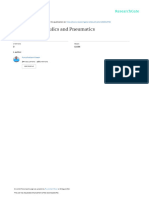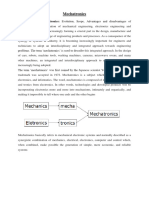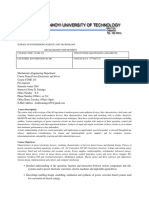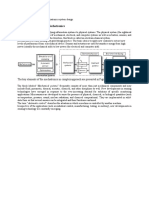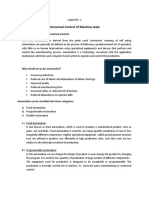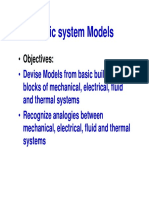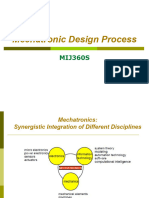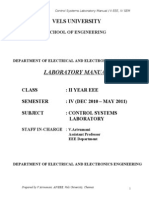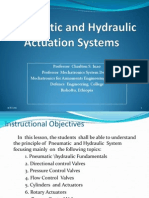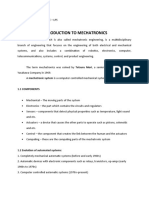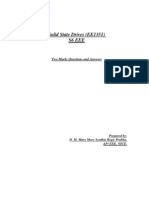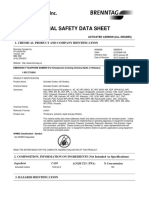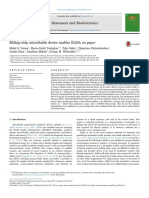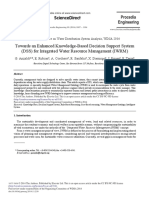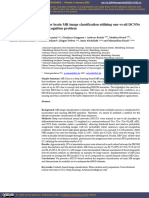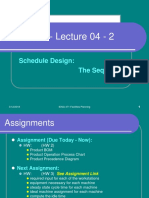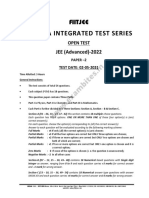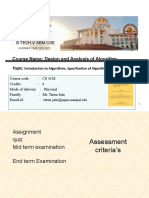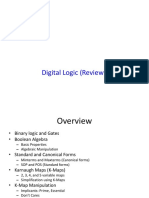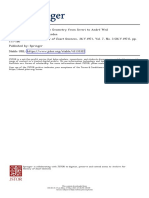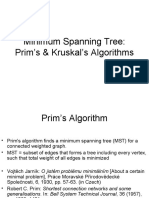0 ratings0% found this document useful (0 votes)
718 views36 pagesMechatronics
This document provides details on a CBT curriculum for mechatronics technology at NVQ levels 5 and 6, including:
1) A list of technical and employability modules for level 5, along with the program structure, module descriptors, learning outcomes, content, and assessments.
2) The modules cover topics like engineering drawing, applied electricity, electronics, hydraulics, pneumatics, engineering materials, PLCs, and mechatronics systems.
3) Employability modules address managing workplace information, communication, and planning work.
4) The curriculum is intended to enable students to apply principles of electrical technology to circuits and machinery safely and efficiently.
Uploaded by
Thusith WijayawardenaCopyright
© © All Rights Reserved
We take content rights seriously. If you suspect this is your content, claim it here.
Available Formats
Download as DOCX, PDF, TXT or read online on Scribd
0 ratings0% found this document useful (0 votes)
718 views36 pagesMechatronics
This document provides details on a CBT curriculum for mechatronics technology at NVQ levels 5 and 6, including:
1) A list of technical and employability modules for level 5, along with the program structure, module descriptors, learning outcomes, content, and assessments.
2) The modules cover topics like engineering drawing, applied electricity, electronics, hydraulics, pneumatics, engineering materials, PLCs, and mechatronics systems.
3) Employability modules address managing workplace information, communication, and planning work.
4) The curriculum is intended to enable students to apply principles of electrical technology to circuits and machinery safely and efficiently.
Uploaded by
Thusith WijayawardenaCopyright
© © All Rights Reserved
We take content rights seriously. If you suspect this is your content, claim it here.
Available Formats
Download as DOCX, PDF, TXT or read online on Scribd
You are on page 1/ 36
p
CBT CURRICULUM FOR
NVQ LEVELS 5 & 6
IN
MECHATRONICS TECHNOLOGY
(CBT Curriculum Code: D33C001)
Developed by
Technical Education Development Project
Ministry of Vocational & Technical Training
Edited by
University of Vocational Technology
No.100, Kandawala Road,
Ratmalana
1
CONTENTS
3
1.Rationale
CBT CURRICULUM
FOR
MECHATRONICS TECHNOLOGY NVQ LEVEL 5
(CBT Curriculum Code: D33T001)
List of Modules Code No.
Technical Modules
1. Engineering Drawing I D33C001M01
2. Applied Electricity D33C001M02
3. Applied Electronics D33C001M03
4. Safety & Workshop Environment D33C001M04
5. Workshop Technology D33C001M05
6. Engineering Mathematics I D33C001M06
7. Hydraulics and Electro Hydraulics systems D33C001M07
8. Pneumatics and Electro Pneumatics systems D33C001M08
9. Engineering Material D33C001M09
10. Programmable logic controller D33C001M10
11. Mechatronics systems I D33C001M11
12. Industrial training - I D33C001M12
Employability Modules
1. Manage Workplace Information EMPM01
2. Manage Workplace Communication EMPM02
3. Plan work to be Performed at Workplace EMPM03
4
PROGRAM STRUCTURE NVQ LEVEL 5
Semester 1
Notional
Lectures/ Practical/ Self-
Module Code Module Type Tutorials Design/ study
hours
site visits
D33C001M01 Engineering Drawing I C 100 30 40 30
D33C001M02 Applied Electricity C 150 70 40 40
D33C001M03 Applied Electronics C 150 70 40 40
D33C001M04 Safety & Workshop Environment C 75 30 25 20
D33C001M05 Workshop Technology C 150 45 75 30
EMPM01 Workplace Information Management C 75 30 25 20
EMPM02 Workplace Communication C 50 20 20 10
Management
Total 750 295 265 190
Semester 2
Notional
Lectures/ Practical/ Self-
Module Code Module Type Tutorials Design/ study
hours
site visits
D33C001M06 Engineering Mathematics I C 100 80 - 20
D33C001M07 Hydraulics and Electro Hydraulics C 100 30 40 30
systems
D33C001M08 Pneumatics and Electro Pneumatics C 100 30 40 30
systems
D33C001M09 Engineering Material C 75 30 20 25
D33C001M10 Programmable logic controller C 150 30 80 40
D33C001M11 Mechatronics systems I C 150 40 70 40
EMPM03 Plan work to be Performed at C 75 30 25 20
Workplace
Total 750 270 275 205
C Compulsory
Industrial Training
Module Code Module Duration (hrs)
D33C001M11 Industrial training - I 720
5
MODULE DESCRIPTOR
Mechatronics Technology- NVQ LEVEL 5
Module Title Engineering Drawing I
Module Code D33C001M01
Module Type Compulsory
Relevant Unit/s of D33T001U07, D33T001U08, D33T001U09, D33T001U10, D33T001U17
Competency
Pre-Requisites
Successful completion of the bridging program
To enable the students to :
Module Aims
Read and Understand Engineering Drawing as engineering
communication media.
Develop competencies to produce freehand sketches, engineering
drawings manually and using computer software
The student will be able to:
Read and interpret engineering drawings
1. Draw the following manually adhering to standards;
Learning Outcomes
Manufacturing drawing including section and assemblies
Isometric and oblique pictorial projection
Screw threads and fastening system
Applications of loci
Produce development drawings
Drawing standards, conventions, line work and tangency
Types of drawing and layouts, Line work, Ink and pencil drawings,
Lettering, Tangency
Orthographic Projection
First angle orthographic projection, third angle orthographic
projection, Auxiliary views, true length
Isometric and oblique pictorial projection
The circle in Isometric projection, irregular curves in isometric
projection, oblique projection.
Applications of loci
Mechanisms, the involutes, Archimedean spiral, the epicycloids, the
helix, right hand square thread, the ellipse
Learning Content /
Intersections and Development
Intersections between geometrical solids, Fillets, developments,
Topics
chord stepping, oblique cone
Screw threads and fastening system
Screw threads, threads for power transmission, multiple threads,
bolts, nuts and washers
Dimensioning methods, limits and fits
Dimensioning, chain dimensioning, dimensioning radii, dimensioning
curves, dimensioning diameters, dimensioning tapers, hole basis
fits, shaft basis fits, selection of tolerances,
Geometrical tolerances
symbols, interpretations
Sections and sectional views, sections in two parallel planes,
successive sections,
10
Lettering, section and assemblies
Dimensioning, chain dimensioning, datum dimensioning, dimensioning
radii, dimensioning curves, dimensioning diameters, dimensioning
Practical
tapers, hole basis fits, shaft basis fits, selection of tolerances,
Screw threads and fastening system
Intersections and Development
Interpret fabrication drawings
Drawing table with drawing boards, Chalk board or white board with
Resources
facilities to draw technical drawings, Drawing models, Drawing
instruments
Prescribed Texts & / or
Standard text books on engineering drawings
Scholars websites
References
Teaching Learning
Lectures
Demonstrations
Activities
Individual practice
Type Topic / Activity Weighting
Continuous 06 Different
60%
Assessment & Weighting
assessment
drawings
Summative
Assembly drawing
40%
assessment
04 hour
Duration 100hrs
11
MODULE DESCRIPTOR
Mechatronics Technology- NVQ LEVEL 5
Module Title Applied Electricity
Module Code D33C001M02
Module Type Compulsory
Relevant Unit/s of D33T001U03, D33T001U09, D33T001U15
Competency
Pre-Requisites Successful completion of the bridging program
Module Aims
To enable the students to :
Apply the principles of electrical technology to electrical circuits and
machinery for managing safe and efficient operation.
The student will be able to :
Explain the electrical principles and techniques relevant to
Learning Outcomes
electrical circuits and machinery
Apply principles and techniques of applied electricity
relevant to electrical circuits and machinery for their safe and
Efficient use.
DC & AC Theory
(OHFWULFDO FXUUHQW DQG 2KPV ODZ, NLUFKRIIV ODZ, Electrostatics and
Capacitance Magnetism & Electromagnetism, AC fundamentals, RLC
series circuits, three phase Circuits
Electrical Machines
DC motors, Speed/torque Control of DC motors, Stepper Motors,
Servo Motors and Motor Drives, Principals of Transformers, Induction
motors, Synchronous motors, Alternators
Learning Content /
Measuring Instruments
Electrical Measurements and Basic Measuring Instruments
Topics
Multimeter,Cliponmeter,Osiloscope,Power factor meter,Megar,Phase
sequence tester
Electrical distribution systems
Circuit breakers, earth fault relay, distribution circuit breakers and
selection of cables
Overload levels of circuit breakers, earth fault relay, phase failure and
leakage relay, surge arrestors, line filters, Type of earth electrode
Electrical systems procedures
9HULILFDWLRQ RI .LUFKRIIV _VW DQG _QG /DZ
RC Time Constants
Superposition Theorem
7KHYHQLQV 7KHRUHP
Simple AC Circuits
Measurement of Power
Practical
Dc motor &Ac motor controls
Phase failure Phase sequins
EFR
MCCB/Earth fault relay under voltage and over voltage
Methods of testing
Distribution and control systems
surge arrestors, line filters
12
Standard laboratory equipment used in Electrical engineering Laboratory,
Resources
Trainer panels to carryout experiments on DC & AC theory and Electrical
Machines.
IEE Regulations
Electrical and Electronic Technology, 9
th
edition Edward Hughes
Revised by John Hiley, Keith Brown, and Ian McKenzie
Smith Pearson Education
Prescribed Texts & / or ISBN 81-317-1468-3
References B.L Theraja and 7KHUDMD $ WH[W ERRN RI (OHFWULFDO 7HFKQRORJ\ 9ROXPH
11
AC and DC Mchines
S. Chand & Co. Ltd.
Lectures
Case studies
Teaching Learning
Field Visits
Tutorials
Activities
Individual assignments
Demonstrations
Individual Practice
Type Topic / Activity Weighting
Continuous
20%
Continuous
assessment
Assessment & Weighting assessment Practicals 30%
Summative 03 hour paper and
50%
assessment
practical
Duration 150hrs
13
MODULE DESCRIPTOR
Mechatronics Technology- NVQ LEVEL 5
Module Title Applied Electronics
Module Code D33C001M03
Module Type Compulsory
Relevant Unit/s of D33T001U04, D33T001U10, D33T001U16
Competency
Pre-Requisites
Successful completion of the bridging program
To enable the students to :
Module Aims
Diagnose and rectify faults in semiconductor devices and analog
circuits
Diagnose and rectify faults in digital electronic circuits and
components of all types of accessories
The student will be able to :
Demonstrate the understanding of the operation, uses and limitations
of measuring instruments used in applied Electronics
Learning Outcomes
Describe the operation of simple semiconductor devices
Describe the operation of Bipolar junction Transistors
Describe the theory and operation of Analog signal processing using
operational amplifiers electronic devices
Describe the theory and operation of digital electronic devices
Semiconductor Electronics
Semiconductor physics as the basis for understanding
Electronics devices.
Junction Diode Zener diodes, voltage regulators,
Optoelectronics Devices, Analysis of Diodes circuits
Bipolar junction Transistors
Bipolar transistor physics, Common emitter transistor circuits, Bipolar
transistor switch, Bipolar transistor packages,FET,Introduction to
Cmos
Analog signal processing using operational amplifiers.
Learning Content /
Amplifiers, operational amplifiers, Inverting amplifier, non inverting
amplifier Difference amplifier, Instrumentation amplifier, integrator,
Topics
Converters (Voltage, Current), Summing Amplifier
Digital circuits
Digital representations, combinational logic and logic families, timing
diagrams, Boolean Algebra, design of logic systems, Truth tables,
Sequential logic, Application of Flip- Flops, Counters, Encoders,
Decoders, Memory Devices, Multiplexers and Demultiplexers
Basic Electronic Measuring Instruments
Types and Applications, Oscilloscopes, Function Generator,
Frequency Counter, Logic Probes
14
Combinational Logic Circuits: checking logic gates operation using
WUDLQHU ERDUGV DQG GHVLJQ XVLQJ VSHFLILHG ORJLF ,&V DQG SHUIRUPLQ
logic IC testing
Applications of Combinational Logic Circuits:Decoder, Encoder,
Practical
Adder, Multiplexer, De-multiplexer, and comparator
Sequential logic Circuits: Checking the operation of Clocks, Flip
Flops, Counters, Shift Registers and design for case study(6 hrs)
Converters:Designing and Trouble shooting ADC / DAC,
Multivibrator circuits
Standard laboratory equipment used in Electronics engineering
Resources
Laboratory, Logic trainer kit, logic probes, Analogue trainer kit,
Oscilloscope, Simulation Software
Prescribed Texts & / or
Digital System-Ronald J.Tocci and Neal S.Widmer (Eighth Edition)
Digital Electronics-Roger L Tockheim/MC Graw Hill
References Electronics-Neil Storey Addition-Weslay
Lectures
Teaching Learning
Case studies
Tutorials
Activities Individual assignments
Demonstrations
Individual Practice
Type Topic / Activity Weighting
Continuous
10%
Continuous
assessment
Assessment & Weighting assessment Practical 30%
Summative 03 hour paper and
60%
assessment
practical
Duration 150hrs
15
MODULE DESCRIPTOR
Mechatronics Technology- NVQ LEVEL 5
Module Title
Safety & Workshop Environment
Module Code
D33C001M04
Module Type
Compulsory
Relevant Unit/s of D33T001U01 to D33T001U19
Competency
Pre-Requisites
n/a
To enable the students to :
understand the workshop environment & safety in workshop
Module Aims Identify Personal safety gears available to protect body
Fresh air
Understand how and when to wear safety equipment such as
masks; Helmet, glasses ,safety goggles, gloves ,Working cloths ,safety
shoes, Guiters; Ear protectors.
The student will be able to:
Use personal safety gears during workshop activities.
Learning Outcomes
Arrange the place of work to avoid health and safety risks.
Arrange the place of work in order to make it possible to work in the
most ergonomic way
Give first aid
Introduction
Definition for the terms Accident & Safety & Importance of safety to
day to day life & Workshop activities
Accident in workshops
Causes of workshop accidents (Electricity, Toxic fumes/liquid, Fire,
Using machinery & tools, Bad housekeeping, Bad material handling
& Carelessness) with examples
Safety in workshop
How to avoid accidents caused by Electricity, Toxic fumes/liquid, Fire,
Learning Content /
Using machinery & tools, Bad housekeeping, Bad material handling &
Carelessness, with examples, Procedure to be followed in case of
Topics
accident & injury in workshop, First aid, Personal safety & safety of
others & Safety gear used in workshop(Fresh air masks; Helmet,
glasses ,Safety goggles, gloves ,Working cloths ,Safety shoes, Guiters;
Ear protectors) Health hazards, how to avoid them and maintenance
and reliability of workshop tools and equipment
Workshop ethics
Workshop attitudes, rules and regulations, workshop behavior toward
the fellow workers & working as a team
Practical Not applicable
16
Safety signs
Fire extinguishers
shield & Helmet, Fresh air mask;Standard glasses, Safety goggles,
Resources
cloths, Guiters, Safety shoes, Ear protectors
safety regulations and codes
First aid kit
Papers/hand outs on related theory,
Welding Skills-Joseph E Giachino William Weeks, American Technical
Publishers-ISBN 0-8269-3001-8
Prescribed Texts & / or
Welding Principles and Applications-Fifth Edition, Larry Jeffus
ISBN 981-254-866-1
References
Factories ordinance
Safety codes
Lectures
Demonstration
Field visits
Guest lectures
Case studies
Discussions
Brainstorming
Teaching Learning
Assignments
Simulations on ;
Activities
Prevent fire and explosion at the place of work
Prevent electrical hazard at the place of work
Prevent radiation to reach fellow workers
Arrange the fume exhaust system
Take action against poisoning by chemical agents
Safe Handling of material, and heavy work pieces
Use fire extinguisher to extinguish fire
Assessment & Weighting
Type Topic / Activity Weighting
Continuous assessment Individual assignments based 40%
on case studies
Summative assessment 03 hour paper 60%
Duration 75hrs
17
MODULE DESCRIPTOR
Mechatronics Technology - NVQ LEVEL 5
Module Title Workshop Technology
Module Code D33C001M05
Module Type Compulsory
Relevant Unit/s of
D33T001U17, D33T001U19
Competency
Pre-Requisites Successful Completion of gap filing programme
To enable the students to :
Module Aims
Understand basic workshop processes & their applications
Perform basic workshop operations
The student will be able to:
Use workshop tools and hand tools to perform common workshop
operations
Learning Outcomes Perform measuring and marking
Perform basic lathe and drilling operations
Demonstrate the understanding of the theory behind the workshop
operations such as metal cutting, drilling grinding, forging etc.
Introduction
Classify workshop processes according to Casting, Mechanical forming,
Cutting, Finishing & Assembling & workshop technology
Drilling
Definition, Importance of drilling, Cutting action of a drilling machine,
Structure of a drilling machine, Types of drilling machine & their
DSSOLFDWLRQV, 7ZLVW GULOO & LWV SDUWV ZLWK WKHLU
DSSOLFDWLRQV, drill, Drill angles, Other Types of drills, Sharpening twist drill bit, Work
holding on a drilling machines, Drilling procedure using hand, bench &
standing drilling machine, Drilling coolants, Drilling speeds & feeds,
Safety in Drilling, Defects on a drilled hole & Day to day maintenance
of drilling machines
Grinding
Definition, Importance of grinding, Cutting action of grinding,
Construction of a Grinding wheel, Grinding wheel types & applications,
Standards of grinding wheel, Truing & cleaning of a grinding wheel,
Learning Content/Topics
Types of grinding machines & their application, Use of bench & standing grinder for
metal cutting & tools grinding, Use Disc grinder for metal
cutting, Safety in grinding & day to day maintenance of grinding wheels
& machines
Machining (Lathe)
Definition, Metal cutting principles, Types of machines used for machines
& their uses, Description of lathe as a machining machine, Cutting action of
a lathe, Structure of a lathe & main components with their uses, Types of
lathe & their applications Power transmission on a lathe, Lathe cutting tools
& Tool geometry of a lathe cutting tool, Coolant used in a lathe machine,
Lathe accessories & their uses, Machining processes used in a lathe
(Centering the work, turning, facing, taper turning, drilling, boring, thread
cutting & parting), Cutting speeds, Machining speeds & feeds of a lathe,
Safety in lathe work & day to day maintenance of a lathe,
Precision measurement, Importance of precision measurement to
machining, Precision measuring instruments types & applications
(Various types of gauges used in machining)
18
Machining (Milling machine)
Description of Milling machine as a machining machine, Cutting action
of a Vertical & horizontal milling machine, Structure of a vertical &
horizontal milling machines & main components with their uses, Power
transmission on a milling machine, Milling cutting tools & Tool
geometry of a milling cutting tool, Coolant used in a milling machine,
Milling machine accessories & their uses, Up milling & down milling,
Machining processes used in a milling machine ( Centering the work,
Flat milling, Vertical milling, Gear cutting & Spiral cutting), Cutting
speeds, Machining speeds & feeds of a milling machine, Safety in
milling work & day to day maintenance of a milling machine
Bench work
Select materials for fitting work
Mark metal piece for processing
Cut metals using chisels
Cut metal using Disc grinder
Cut metals using Hacksaw
Cut metals using File
Drill Holes using hand drill
Drill holes using Bench or Standing drill
Practical
Sheet metal work
Select Materials for sheet metal work
Mark sheet metal for processing
Cut metals using snips
Form sheet metals using hand
tools Assemble sheet metal
component Soldering
brazing
Work benches, Bench tools of various types & sizes (Vices, Chisels,
Hammers, Files, Hacksaws, Taps & die sets, Reamer set , Hand vices),
Basic hand tools, Basic Marking tools, Basic Measuring tools, Micro meters,
Vernier callipers, Dial gauges, Height gauges, Thread gauges, Radius
gauges, Taper gauges, Hand drill, Bench drill or Pedestal drill, Sets of twist
drills, Disc grinder, Bench or pedestal grinder, Grinding wheels for normal
Resources
use, Riveting tools set, Leg vice, Forge fire, Anvil, Forging tools of various
types & sizes (Forge fire, Anvil, Hammers, Punches, Chisels, Swages,
Fullers, Rivet headers, Bolt headers, bending links, & tongs), Sheet metal
tools of various types & sizes (Marking tools, Chisels, Mallets, Hammers,
Snips, pliers, Tongs, Stakes etc.)
Prescribed Texts & / or
Workshop Technology by W Chapman
References
Lectures
Tutorials
Teaching Learning
Individual assignments
Activities
Demonstrations
Individual Practice
19
Type Topic / Activity Weighting
Practical
Mark metal piece for
processing
Cut metals using chisels
Cut metal using Disc grinder
Cut metals using Hacksaw
Cut metals using File
Continuous
Drill Holes using hand drill 40%
Assessment & Weighting
Drill holes using Bench or
assessment Standing drill
Assemble metal components
using rivets
Cut internal threads using taps
Cut external thread using dies
Individual assignment 20%
Summative
03 hour paper and practical 40%
assessment
Duration 150hrs
20
MODULE DESCRIPTOR
Mechatronics Technology
Module Title Manage Workplace Information
Module Code EMPM01
Module Type Compulsory
Relevant unit/s of
EMPU01
Competence
Pre-Requisites None
To enable the students to:
Module Aims
Make use of information and information systems to carry out
organizational functions
Make use of information and information systems to enhance workplace
performance
The student shall be able to:
Explain the importance of ICT tools in promoting the productivity of the
Learning Outcomes organization
Describes the purpose of establishing ICT tools and strategies in
enhancing the performance at workplace
Apply Information skills to enhance the productivity of the organization
Identification of documentation requirements
Selecting and/or collecting required documentation
Documentation procedures and methods
Completing /perfecting documentation
Reading, interpreting and using equipment/system manuals and
specifications
Interpretation of all applicable laws, policies and procedures relevant to
Learning Content /
enterprise
Computer and information system usage
Topics Forecasting Techniques
Forecasting Software
Mathematical Modeling
Data Collection Techniques for Market Research
The range of analytical techniques appropriate for analysis of information
The influence of human factors on information analysis, e.g. Prejudices
and biases
Conducting and recording of performance evaluations
Occupational Tools, Instruments, Equipment, material
Documents on Company policies and procedures
Calculator
Computer
MIS resources
Software used for information purposes
Equipment/system manuals and specifications
Resources: Equipment, Safety signs
Tools & Materials Safety procedures
Forecasting Software
Variety of forms, formats used in the organization
Instructional Tools, Instruments, Equipment, material
Multimedia projector
Screen
Flash cards
Flip charts
21
Permanent and white board markers
Overhead projector
Printer
Transparencies
Colour Printer and scanner
Safety manuals
Safety illustrations
Prescribed Texts & / or
References
Discuss/ explain and provide essential theoretical inputs
Emphasize the importance of a valid information system in promoting
customer relations - make reference to following
- Identification of customer needs
- Measurement of customer needs and satisfaction
Teaching Learning
- Obtaining feedback from customers
- Recognition and understanding of customer problems and resolution
Activities
or timely referral of problem in a manner satisfactory to the customer
Application of enterprise policies in satisfying customer needs
Identifying enterprise Protocols associated with "Customer Services"
Discuss "Satisfying customer complaints" using information sources
available
Type Topic / Activity Weighting
Knowledge on various
Assessment & Weighting
aspects of information
30%
management skills at work
place
Oral questioning on various
aspects of information
Continuous assessment management skills at work 10%
place
Multiple Choice Test Items/
Matching and Completion
10%
test items and structured
essay type questions
Summative assessment Use of ICT Tools, Software
applications, application of
information management
skills 50%
Viva voce knowledge on
application of information
management skills
Duration 75hrs
22
MODULE DESCRIPTOR
Mechatronics Technology - NVQ LEVEL 5
Module Title Manage Workplace Communications
Module Code EMPM02
Module Type Compulsory
Relevant Unit/s of EMPU02
competence
Pre-Requisites None
To enable the students to :
Module Aims
Apply communication skills to maintain effective workplace
performance
Adjust to diverse situations at workplace, through effective
manipulation of communication skills
The student shall be able to :
Identify the essential components of an efficient communication
system
Learning Outcomes
Identify and overcome barriers to effective communication
Use all channels of communication equally well
Use common computer applications to collect, analyze and maintain
essential data and information required to perform and enhance day
to day activities of the organisation
Contributes to the overall growth and productivity development of the
organization
Basic communication models - (Reference to 2 typical models)
Principles of effective, interactive communication
Barriers to effective communication and distortions in the
communication process
Personal values and communication
Learning Content /
Policies of the organization relevant to information and
communication function
Topics
Protocol and Procedures of the organization
Importance of ICT tools in promoting the efficiency and effectiveness
of the organization
Common computer applications
Importance of networking in day to day activities of the organization
Occupational Tools, Instruments, Equipment, material
Company policies and procedures
Software used for information/communication purposes
Safety signs
Resources: Equipment, Safety procedures
Tools & Materials Variety of forms, formats used within the organization and for external
communication
Calculator
Computer
23
Instructional Tools, Instruments, Equipment, material
Multimedia projector
Screen
Flash cards
Flip charts
Permanent and white board markers
Overhead projectors
Transparencies
Communication models
Colour Printer and scanner
Safety manuals
Safety illustrations
Prescribed Texts & / or
References
Knowledge to be imparted by providing learner centered activities
Facilitator may use different teaching methodologies such as
brainstorming, projects, mind mapping, small group activities,
illustrated talk, fish ball technique, demonstrations, when delivering
knowledge component of this module
The following may be discussed in groups of trainees and followed up
Teaching Learning
with Exercises" & "Role plays"
Oral communication
Activities Written communication
The following may be discussed in groups of trainees and followed up
ZLWK ([HUFLVHV" & 5ROH SOD\V"
Constructing sound inductive arguments.
Reading and comprehending written communications and information
Using job-related terminology
Using proper listening techniques
Type Topic / Activity Weighting
Multiple Choice Test
Items/ Matching and
Assessment & Weighting
Completion test
Continuous
items and structured
assessment
essay type 30%
questions
on various aspects
of communication
skills at work place
Oral questioning 10%
during class room
on various aspects
of communication
skills at work place
Summative
Viva voce 30%
knowledge on
assessment application of
communication skills
Paper using 30%
structured essay
type questions
Duration 50hrs
24
MODULE DESCRIPTOR
Mechatronics Technology - NVQ LEVEL 5
Module Title Engineering Mathematics I
Module Code D33C001M06
Module Type Compulsory
Relevant Unit/s of D33T001U01 to D33T001U19
Competency
Pre-Requisites
Successful Completion of gap filing programme
Module Aims
To enable the students to :develop understanding on the application of
mathematical concepts in technology
The student will be able to :
Prove Quadratic and Polynomial equation
Prove binomial, remainder and factor theorem
Apply trigonometry to find area of any triangle
Explain basic operations with complex numbers, Addition, Subtraction,
Multiplication & Division
Learning Outcomes Differentiate common engineering functions
Perform Integration of simple algebraic, Logarithm, Exponential &
Trigonometric functions
Perform differential equations
Apply differential equations in practical situations
Perform Properties of Matrices
Apply Properties of Matrices in practical situations
Quadratic and Polynomial equations, Partial fractions, Binomial
Theorem, Remainder theorem and Factor theorem
Properties of triangle, Sine and Cosine rules, Applications of
Trigonometry to find the area of any triangle
&RPSOH[ QXPEHUV ,PDJLQDU\ DQG LWV V\PERO, 8VH RI WKDW V\PERO WR
avoid confusion, Complex number, Pure imaginary number,
Rectangular form of complex number, Real & Imaginary part of a
complex number, Expression of complex number in terms of
imaginary unit symbol, Basic operations with complex numbers,
Learning Content/Topics
Addition, Subtraction, Multiplication & Division
Differentiation of common engineering functions, Sums, Products,
Quotient, Function of a function rule, Second derivation, Maxima and
minima
Integration of simple algebraic, Logarithm, Exponential &
Trigonometric functions, Integration methods such as partial
functions,
Substitutions and by parts
Properties of Matrices, Addition, Subtraction, Multiplication & Division of
Matrices, Applications of Matrices
Practical
25
Resources
Chalk board or white board, Over Head Projector with soft wear & Computer
with multi-media projector
Shanti Narayan and P K Mital, A text book of Matrices, ISBN 81-219-
2596-7, S Chand & company Ltd. New Delhi
Frank Ayres J R, Theory and problems of Matrices, ISBN 0-07-99035-2,
Schaum's outline series
Otto Bretscher, Linear Algebra with applications, ISBN 81-317-1441-1,
Prescribed Texts & / or
Dorling Kindersley Pvt Ltd
Seumour Cipschutz, Theory and problems of Linear Algebra, ISBN 0-07-
References 99012-3, Schaum's outline series
K.J. Delvin (1993), The Joy of Sets : Fundamentals of
Contemporary Set Theory (Undergraduate Texts in Mathematics),
Springer-Verlag
TMJA Cooray, Advanced Mathematics for Engineers, Volume 1, ISBN
955-9027-12-3, Cooray publishers
Teaching Learning
Lectures
Tutorials
Activities
Individual assignments
Type Topic / Activity Weighting
Assessment & Weighting
Continuous
Continuous assessment
40%
assessment
Summative
03 hour paper and practical
60%
assessment
Duration 100hrs
26
MODULE DESCRIPTOR
Mechatronics Technology - NVQ LEVEL 5
Module Title Hydraulics and Electro Hydraulics systems
Module Code D33C001M07
Module Type Compulsory
Relevant Unit/s of D33T001U01, D33T001U05, D33T001U07, D33T001U13
Competency
Pre-Requisites
NVQ Level 4 of Mechanical / Electrical / Electronics
To enable the students to :
Apply the principles of hydraulic &Electro Hydraulics controls to
Module Aims
machinery
Explain types and elements of hydraulic & Electro Hydraulics circuits
Define the functions of elements and circuits
Read and analyze hydraulic & Electro Hydraulics circuit diagrams
The student will be able to :
Describe the theory and operation of Fluid Pressure and its
Learning Outcomes
Measurements
Describe the theory and operation of hydraulic systems
Select components for hydraulic & Electro Hydraulics circuits
Develop hydraulic & Electro Hydraulics circuits
Introduction
Units of Measurements, Properties of fluids, Capillarity of water, Static
head Kinetic or velocity head, Position, potential or geodetic head,
Negative vacuum or suction head.
Fluid Pressure and its Measurements
Pressure head, pressure, Pressure recording devices, Piezometer,
tube, Manometers (Simple manometer, Micro Manometer, Differential
Learning Content / Manometer Inverted differential manometer.)
Topics Introduction to Hydrostatics
Introduction to 3DVFDOV /DZ, 7RWDO 3UHVVXUH, 7RWDO SUHVVXUH RQ D
horizontally immersed surface Total pressure on a vertical immersed
surface, Center of Pressure
Introduction to Flow through pipes
Types of flow in pipes, Loss of head in pipes.
Basic Hydraulic Circuits
Application of various valves and devices
Basic hydraulics circuits, such as Pressure sequence circuit, Pump
bypasses, differential circuits, feed and return circuits, bypass
Practical
circuits, counter pressure and bypasses using anon-return valve
Application of 2/2,3/2,4/2 and 4/3-way valves, one way flow control
valve
Application of rectifier circuit, memory circuits
27
Resources
Hydraulic Training Kit
Fluid Power with Applications, Anthony Esposito, Prentice Hall of
India, 2003
Application, 4
th
Edition,
Prescribed Texts & / or
J.A. Sullivan, Fluid Power: Theory and
Prentice Hall, 1998, ISBN 0137555881.
References
F.Yeaple Fluid Power Design Handbook, 3rd Edition, Marcel Dekker,
1995, ISBN 0824795628.
Lectures
Teaching Learning
Lab practical
Tutorials
Activities Assignments
Demonstration of practical work
Simulated Industrial applications
Type Topic / Activity Weighting
Continuous
Tutorial 20%
Lab practical 20%
Assessment & Weighting assessment Individual 20%
assignment
Summative 03 hour written
40%
assessment
paper
Duration 100hrs
28
MODULE DESCRIPTOR
Mechatronics Technology - NVQ LEVEL 5
Module Title Pneumatics and Electro Pneumatics systems
Module Code D33C001M08
Module Type Compulsory
Relevant Unit/s of
D33T001U02, D33T001U05, D33T001U09, D33T001U06, D33T001U08,
D33T001U14
Competency
Pre-Requisites NVQ Level 4 of Mechanical / Electrical / Electronics
To enable the students to :
Apply the principles of pneumatic & Electro Pneumatics controls to
Module Aims
machinery
Explain types and elements of Pneumatics & Electro Pneumatics
circuits
Define the functions of elements and circuits
Read and analyze Pneumatics & Electro Pneumatics circuit diagrams
The student will be able to :
Describe the theory and operation of Pneumatics & Electro
Learning Outcomes Pneumatics systems
Select components for Pneumatics & Electro Pneumatics circuits
Develop Pneumatics & Electro Pneumatics circuits
Introduction
Physical quantities and units of pneumatics
Physical properties and laws of air
Air and influence of heat and pressure
Water absorption capacity of air
Air and the influence of flow speed and pressure
Learning Content /
Compressed air as a working medium
Pneumatic supply units:
Topics
Compressors, cooler, compressed-air container, filter, valves, etc.
Basic pneumatic circuits
Pressure and speed control circuits, Sequencing and air logic control
Circuit, Electro pneumatic control circuits, Vacuum circuits .
Pneumatic components
Pneumatic actuators, Directional valves, Flow valves, Quick exhaust
Valves
Application of single-acting and double-acting cylinders, rotary drives
Application and function of 3/2 and 5/2-way valves
Logic operations: explaining and implementing AND/OR/NOT
operations
Combining logic operations
Function and application of limit switches
Practical
Converting 5/2-way valves
Basic stepper control(continuous cycle)
Setting and coordinating time delays
Evaluating and using sensors for material sensing
Realising stepper control with protected pilot air and auxiliary function
Combined use of quick exhaust valves and pressure regulators
29
Resources Pneumatic Training Panel
Pneumatic Controls, Joji P., Wiley Precise Text Book, Wiley
Prescribed Texts & / or
India Pvt Ltd., 2008
J.A. Sullivan, Fluid Power: Theory and Application, 4th
References
Edition, Prentice Hall, 1998, ISBN 0137555881.
Lectures
Teaching Learning
Lab practical
Tutorials
Activities Assignments
Demonstration of practical work
Simulated Industrial applications
Assessment & Weighting
Type Topic / Activity Weighting
Continuous Tutorial 10%
assessment
Lab practical 30%
Individual
20%
assignment
Summative
written paper 40%
assessment
Duration 100hrs
30
MODULE DESCRIPTOR
Mechatronics Technology - NVQ LEVEL 5
Module Title Engineering Materials
Module Code D33C001M09
Module Type Compulsory
Relevant Unit/s of D33T001U19, D33T001U17
Competency
Pre-Requisites
Successful completion of the Bridging program
Foundation mathematics, science and English
Module Aims
To enable the students to :
Apply the principles of strength of materialsto design machine
components
The student will be able to:
Explain the characteristics of materials for the use in machinery and
components
Learning Outcomes
Select relevant materials for producing machinery and components
Determine the stresses in machine components by applying
techniques relevant for analysing loading situations.
Apply principles and techniques of material and component testing
Analyse causes of machine components failure
Metals, Alloys, Polymers, Ceramics & Composites and their
structures & properties
Learning Content /
Stress analysis for shearing, tension, compression, bending and
torsion
Topics
Causes of component failure
Destructive and non-destructive testing of materials and components
Case studies of materials engineering
Impact testing
Hardness testing
Practical
Tensile / compression testing
Torsion testing
Microscopic examination of material structure
Students need access to materials testing laboratory for observing and
Resources
participating in the materials testing and stress analysis. Samples of
failed machine components will be useful.
Workshop Technology by W Chapman
Introduction to Engineering Materials, Vernon, John, Polgrave,
McMillan, 4th edition
Prescribed Texts & / or
Solving problems in Solid Mechanics, S.A. Urry, P.I. Turner,
Longman Scientific Technical, Vol. I and II.
References
Introduction to Engineering Materials, B.K. Agrawal, Tata
McGraw hill, New Delhi.
31
Lectures
Teaching Learning
Lab practical
Tutorials
Activities
Field visits to material processing industries
Assignments
Type Topic / Activity Weighting
Continuous
Tutorial 20%
Lab practical 20%
Assessment & Weighting assessment Individual 10%
assignment
Summative 03 hour written
50%
assessment paper
Duration 75hrs
32
MODULE DESCRIPTOR
Mechatronics Technology - NVQ LEVEL 5
Module Title Programmable Logic Controllers
Module Code D33C001M10
Module Type Compulsory
Relevant Unit/s of
D33T001U05, D33T001U06, D33T001U07, D33T001U08,D33T001U09,
D33T001U10, D33T001U11, D33T001U18
Competency
Pre-Requisites
NVQ Level 4 of Mechanical / Electrical / Electronics
Module Aims To enable the students to :
Design, applications of logic control using modern PLC
Learning Outcomes
The student will be able to :
Develop programs for given open and closed loop applications
Program integrated systems using PLC
Overview of PLC compared with microprocessor based systems,
basic principles of a PLC, Advantages of PLC systems, PLC
manufacturers. Components of a PLC system (hardware and
software),
Structure of PLC(I/O modules and specifications), configure PLC,
Learning Content / Binary operations, timers and counters, design control systems,
Topics program the PLC, programming methods(computer or console),
programming languages, PLC memory, Scan cycle, timers, counters,
memory types, organize the memory program, selecting a PLC
Basic programming with statement list, Ladder diagram, function
chart, Functional block diagram
Practical Practical to be decided by the lecturer using with the available training kit
Resources
PLC Training Panel or kit
Prescribed Texts & / or
David A. Geller: Programmable Controllers Using the Allen-Bradley SLC-
500 Family, Prentice Hall.
References
Colin D. Simpson: Programmable Logic Controllers, Prentice Hall.
Lectures
Teaching Learning Lab practical
Activities Tutorials
Assignments
Demonstration of practical work
Type Topic / Activity Weighting
Continuous
Tutorial 10%
Lab practical 30%
Assessment & Weighting assessment Individual 20%
assignment
Summative
written paper
40%
assessment
Duration 150hrs
33
MODULE DESCRIPTOR
Mechatronics Technology - NVQ LEVEL 5
Module Title Mechatronics System I
Module Code D33C001M11
Module Type Compulsory
Relevant Unit/s of
D33T001U01, D33T001U02, D33T001U05, D33T001U07, D33T001U08,
D33T001U11, D33T001U13, D33T001U14
Competency
Pre-Requisites
Successful completion of the semester one modules
To enable the students to :
Understand basic Mechatronics processes & their applications
Apply the principles of hydraulic &Electro Hydraulics controls to
machinery
Module Aims
Apply the principles of Pneumatics & Electro Pneumatics circuits
controls to machinery
Understand the hydraulic & Electro Hydraulics circuits
Understand the Pneumatics & Electro Pneumatics circuits
Design deferent applications of logic control using PLC
Understand the PIC programming
The student will be able to :
Describe Mechatronics processes & their applications
Learning Outcomes
Describe the theory and operation of Electronic Sensors
Develop advance hydraulic & Electro Hydraulics circuits
Develop advance Pneumatics & Electro Pneumatics circuits
Develop programs for deferent applications
Develop PIC programmes
Introduction
'HILQLWLRQ IRU 0HFKDWURQLFV 7HFKQRORJ\ & LWV UHODWLRQ WR
mechanical, electrical, electronics technology areas, Mechatronics
Technology as Design, Manufacture & Maintenance,
Electronic Sensors
Inductive sensors, Magnetic Sensors, Capacitive Sensors, Pressure
Learning Content /
Sensors, Temperature Sensors, Photo Electric Sensors
Topics Advance hydraulic & Electro Hydraulics circuits
Actuators, Control valves & Hydraulic Power Pack
Advance Pneumatics & Electro Pneumatics circuits
Advance programming with statement list, Ladder diagram, function
chart, Functional block diagram
PIC programming applications
Practical
Practical to be decided by the lecturer using with the available training
kits
Hydraulic Training Kit
Resources
Pneumatics Training Kit
PLC Training Panel or kit
34
Fluid Power with Applications, Anthony Esposito, Prentice
Hall of India, 2003
J.A. Sullivan, Fluid Power: Theory and Application, 4th
Edition, Prentice Hall, 1998, ISBN 0137555881.
F.Yeaple Fluid Power Design Handbook, 3rd Edition,
Marcel Dekker, 1995, ISBN 0824795628.
Prescribed Texts & / or David A. Geller: Programmable Controllers Using the Allen-Bradley
References SLC-500 Family, Prentice Hall.
Colin D. Simpson: Programmable Logic Controllers, Prentice Hall.
Pneumatic Controls, Joji P., Wiley Precise Text Book, Wiley
India Pvt Ltd., 2008
Application, 4
th
Edition,
J.A. Sullivan, Fluid Power: Theory and
Prentice Hall, 1998, ISBN 0137555881.
Lectures
Teaching Learning
Lab practical
Tutorials
Activities Assignments
Demonstration of practical work
Simulated Industrial applications
Type Topic / Activity Weighting
Continuous
Tutorial 10%
Lab practical 20%
Assessment & Weighting assessment Individual 30%
assignment
Summative 03 hour written
40%
assessment
paper
Duration 150hrs
35
MODULE DESCRIPTOR
Mechatronics Technology - NVQ LEVEL 5
Module Title Plan Work to be Performed at Workplace
Module Code EMPM03
Module Type Compulsory
Relevant unit/s of
EMPU03
competence
Pre-Requisites None
To enable the students to :
Module Aims
Plan and schedule work to be performed at workplace
Assign work to workers based on assessment of competencies / work
capacities of individual workers/working team
Predict likely problems / probable changes that would come up in
implementation of planned schedule
The student shall be able to :
Prepare a work schedule for a given work situation
Learning Outcomes
Determine work priorities as per predetermined criteria such as goals,
targets and organizational requirements
Develop a plan (process) to complete work to be done in a given
situation
Assess competencies of individual workers before assigning work
Goals and Objectives of the organization
Planning priorities
Plans related to work and related activities at workplace
Systems, procedures and processes relevant to the organization
Quality and continuous improvement processes applied within the
organization
Company specific performance standards
Learning Content / Topics
Industry/Workplace Codes of Practice /Codes of ethics
Frontline management roles applicable to team management
Manufacturer' s specifications and product specifications
Standard specifications of commonly used materials
Simple planning techniques/methods - ( two to three common
techniques/methods)
Forecasting Techniques /methods
Time management techniques
Competency assessment methods
Occupational Tools, Instruments, Equipment, material
Documents on Company policies and Procedures
Documents on Industry/Workplace
Codes of Practice /Codes of ethics
Documents on Manufacturer' s specifications and product
Resources: Equipment,
specifications
Tools & Materials Documents on competency based assessments
Software used for planning/scheduling
Software applications used in performance appraisal
Safety signs
Safety procedures
36
Computer
Calculator
Instructional Tools, Instruments, Equipment, material
Multimedia projector
Screen
Flash cards
Flip chart
Permanent markers
White board markers
Overhead projector
Transparencies
Colour Printer and scanner
Safety manuals
Safety illustrations
Prescribed Texts & / or
References
Small group activity -1 - Identify work requirements of a drawing
office or of a given project
Small group activity -2 - Set work priorities as per organisational
requirements goals and targets
Small group activity -3 -Develop a plan (process) to complete work to
be done at drawing office or in a given project
Individual activity - Prepare list/s of tools, equipment, material
Teaching Learning required to complete the work as indicated in the plan developed in
Activities activity -3
Small group activity -4 Brainstorm in groups to identify,
1) Deficiencies in the plan (Developed in activity -3)
2) Modifications to be made to overcome deficiencies
Explain and follow up with exercises
Forecasting methods / Techniques, Time management techniques,
Competency assessment methods
Type Topic / Activity Weighting
Assessment & Weighting
Multiple Choice Test Items/
Matching and Completion test
items and structured essay type
30%
questions on various aspects of
Continuous
planning of work to be
performed at workplace
assessment
Oral questioning during class 10%
room presentations on various
aspects of planning of work to
be performed at workplace
Viva voce on application of 10%
planning of work in a given work
Summative
situation
Paper on use of different 50%
assessment approaches and techniques
related to planning of work,
application of skills in Planning
work
Duration 75 hrs
37
MODULE DESCRIPTOR
Mechatronics Technology - NVQ LEVEL 5
Module Title Industrial Training I
Module Code D33C001M12
Module Type Compulsory
Relevant Unit/s of D33T001U01 to D33T001U10,EMPU01 to EMPU03
Competency
Pre-Requisites
Successful completion of modules D33T001M01 to D33T001M11 and
EMPM01 to EMPM 03 during the institutional training
To enable the students to :
Module Aims Get familiarize to industry culture and practices
Consolidate the institutional learning by applying what they leant in
to real world of work situations
The students will be able to :
Analyse industrial situations for developing appropriate
Learning Outcomes technical and managerial solutions
Select suitable approaches for solving problems
Implement solutions for improving production performance
Nature and context of production systems as technical and
business entities
Appraisal of internal and external environment of production
system for growing and becoming competitive
Learning Content / Selection and application of technical and management
Topics concepts and techniques that are appropriate in a given
scenario
Analysis of limitations of the technical concepts and
Techniques under practical situations
Case studies
Practical Industrial Projects
Resources
Students will need access to industrial/ Automation organizations.
Prescribed Texts & / or
Training Guide book.
Industry Handbooks on Technology and Management.
References
Formal involvement of the student in real field situations
Appropriate interactions with teaching staff/ training
supervisor for mentoring and technical guidance
Teaching Learning Problem solving using underpinning knowledge and skills
Activities Demonstration of practical work
Involvement in practical work by students
Industrial project assignments
Preparation of training report
38
Type Topic / Activity Weighting
Successful
Training log book
completion of all 50% of overall
practical activities Mark
and daily
Report.
Assessment & Weighting
Final Training
General report on 30% of overall
training Mark
Report
Outcomes to data
Viva and/or oral General test on all 20 % of overall
presentation topics. Mark
Duration 6 months full time
39
You might also like
- NPTEL Phase II - Electrical Engineering - Embedded SystemsNo ratings yetNPTEL Phase II - Electrical Engineering - Embedded Systems4 pages
- Mechatronics: Integration and ApplicationsNo ratings yetMechatronics: Integration and Applications20 pages
- PDF CH 1 Understanding Mechatronics Final19 - 08 - 2024No ratings yetPDF CH 1 Understanding Mechatronics Final19 - 08 - 202482 pages
- Group 15 EMD332 Machine Design Report - 2D Camera Slider100% (1)Group 15 EMD332 Machine Design Report - 2D Camera Slider33 pages
- Anna University Practical Lab Manuals For Engineering StudentsNo ratings yetAnna University Practical Lab Manuals For Engineering Students13 pages
- Abes Engineering College, Ghaziabad: Department of Electronics & Communication EngineeringNo ratings yetAbes Engineering College, Ghaziabad: Department of Electronics & Communication Engineering80 pages
- Speed Control of A Switched Reluctance MotorNo ratings yetSpeed Control of A Switched Reluctance Motor79 pages
- Unit 1-MECHATRONICS, SENSORS AND TRANSDUCERS100% (3)Unit 1-MECHATRONICS, SENSORS AND TRANSDUCERS55 pages
- Modeling and Simulation of EHV (402034MJ) : Name of Author: Mr. Ravikant K. NanwatkarNo ratings yetModeling and Simulation of EHV (402034MJ) : Name of Author: Mr. Ravikant K. Nanwatkar64 pages
- Pe-4030 CH 4 Pneumatic and Hydraulic Actuation System Oct 29No ratings yetPe-4030 CH 4 Pneumatic and Hydraulic Actuation System Oct 2999 pages
- Cylinders in Series: Essential To ChooseNo ratings yetCylinders in Series: Essential To Choose28 pages
- Design and Implementation of Conveyor Belt Speed Control Using PID For Industrial Applications100% (1)Design and Implementation of Conveyor Belt Speed Control Using PID For Industrial Applications6 pages
- Department of Collegiate and Technical EducationNo ratings yetDepartment of Collegiate and Technical Education16 pages
- Electrical and Electronics Principles ModuleNo ratings yetElectrical and Electronics Principles Module6 pages
- Mechatronics Integrated Technologies 1-4No ratings yetMechatronics Integrated Technologies 1-48 pages
- Treatment and Prevention of Childhood Obesity: Sponsored byNo ratings yetTreatment and Prevention of Childhood Obesity: Sponsored by4 pages
- Molybdenum and Its Compounds: 1 Characterization of The SubstanceNo ratings yetMolybdenum and Its Compounds: 1 Characterization of The Substance21 pages
- Research & Development Report No. RD 2076No ratings yetResearch & Development Report No. RD 20769 pages
- Bishop 2016 Nanotechnology 27 284002 PDFNo ratings yetBishop 2016 Nanotechnology 27 284002 PDF9 pages
- Br0917bioluminescent Reporter Assaysoverview 00a PDFNo ratings yetBr0917bioluminescent Reporter Assaysoverview 00a PDF84 pages
- Towards An Enhanced Knowledge-Based Decision Support System (DSS) For Integrated Water Resource Management (IWRM)No ratings yetTowards An Enhanced Knowledge-Based Decision Support System (DSS) For Integrated Water Resource Management (IWRM)8 pages
- Black Hole: Presented by SWMDWN B 1AH15AE042No ratings yetBlack Hole: Presented by SWMDWN B 1AH15AE04216 pages
- MR-Class A Python Tool For Brain MR Image ClassifiNo ratings yetMR-Class A Python Tool For Brain MR Image Classifi18 pages
- (Ebook) A Practical Approach To Motor Vehicle Engineering and Maint. by A. Bonnick, D. Newbold ISBN 9781865843834, 9780750663144, 1865843830, 0750663146 Download100% (1)(Ebook) A Practical Approach To Motor Vehicle Engineering and Maint. by A. Bonnick, D. Newbold ISBN 9781865843834, 9780750663144, 1865843830, 0750663146 Download111 pages
- IENG 471 - Lecture 04 - 2: Schedule Design: The SequelNo ratings yetIENG 471 - Lecture 04 - 2: Schedule Design: The Sequel12 pages
- Data Handling Analog Io Selection of PLCNo ratings yetData Handling Analog Io Selection of PLC14 pages
- The Determinacy of Long Games Reprint 2015 Itay Neeman Download100% (4)The Determinacy of Long Games Reprint 2015 Itay Neeman Download87 pages
- Thermodynamics Related To The Civil Engineering: Zeroth Law of ThermodynamicsNo ratings yetThermodynamics Related To The Civil Engineering: Zeroth Law of Thermodynamics5 pages
- Thomas Timmermann - An Invitation To Quantum Groups and Duality (Ems Textbooks in Mathematics) - European Mathematical Society (2008) PDF100% (1)Thomas Timmermann - An Invitation To Quantum Groups and Duality (Ems Textbooks in Mathematics) - European Mathematical Society (2008) PDF427 pages
- The Foundation of Algebraic Geometry From Severi To André WeilNo ratings yetThe Foundation of Algebraic Geometry From Severi To André Weil11 pages
- Self-Supervised Learning-Based General Laboratory Progress Pretrained Model For Cardiovascular Event DetectionNo ratings yetSelf-Supervised Learning-Based General Laboratory Progress Pretrained Model For Cardiovascular Event Detection13 pages



